Effortless Overnight No-Knead Bread: Your Guide to Perfect Homemade Loaves
Get ready to experience the unparalleled joy and fresh, delicious taste of homemade overnight bread! This incredible recipe requires absolutely no kneading, making it accessible even for novice bakers. Forget complicated techniques or specialized equipment – simply mix the ingredients, let the magic happen overnight, and bake a stunning, crusty loaf that will fill your home with an irresistible aroma.
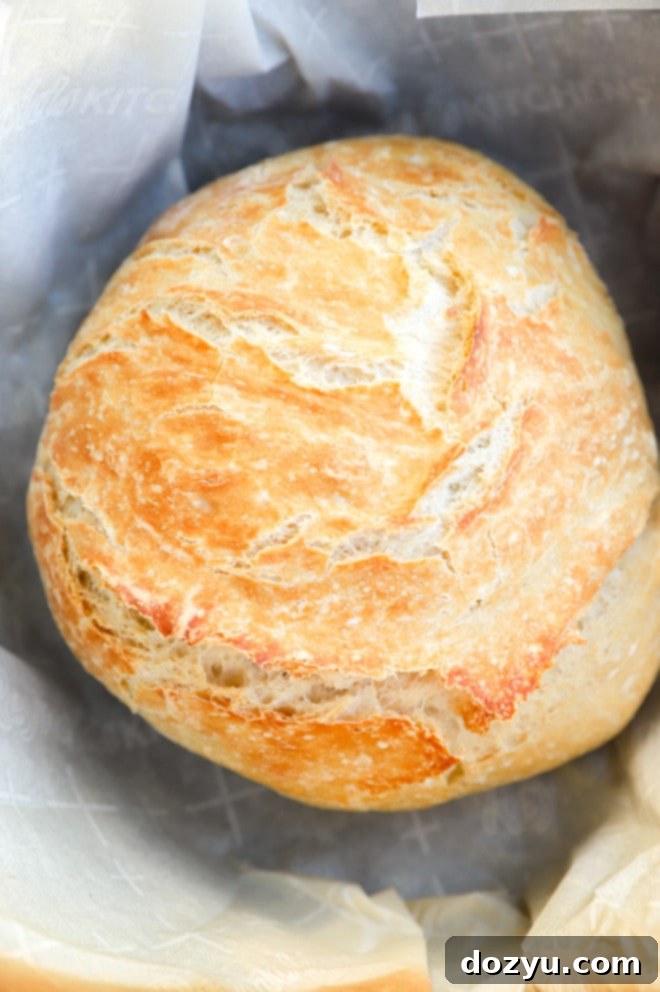
table of contents
Toggle
About This No-Knead Overnight Bread
There’s an undeniable magic to a freshly baked loaf of bread. It’s more than just food; it’s a symbol of comfort, tradition, and warmth that evokes cherished memories for many of us. From the simple delight of a childhood peanut butter and jelly sandwich to sharing a crusty loaf alongside a hearty bowl of soup, bread holds a special place in our hearts and kitchens. It offers a unique opportunity for connection, nostalgia, and ultimate culinary comfort.
In our busy lives, taking the time to cultivate a sourdough starter or follow a lengthy, traditional artisan bread recipe can feel daunting. That’s why this no-knead overnight bread recipe is a game-changer. It’s designed for ease and convenience, allowing you to enjoy authentic homemade bread without the extensive time commitment often associated with baking. This method simplifies the process, making it perfectly suited for weekly enjoyment.
This particular recipe is remarkably basic, requiring only four core ingredients, yet it yields a result that tastes anything but simple. As it bakes, your entire home will be enveloped in the glorious, comforting scent of fresh bread, a true sensory delight that brings immense joy. What makes this recipe truly special is its accessibility: you don’t need to be an experienced baker to achieve impressive results. The simple mixing, followed by an overnight rest, allows the yeast to work its magic slowly, developing incredible flavor and a beautiful texture with minimal effort from you. While you do patiently wait for the dough to rise, the anticipation is well worth it when you wake up to the prospect of warm, fresh-baked bread.
Whether you crave a crisp slice of toast with your morning coffee, a gooey grilled cheese for lunch, or a generous hunk to dip into your favorite soup, this overnight bread seamlessly integrates into your routine. It’s a quick, effortless way to elevate your everyday meals with the wholesome goodness of homemade bread. Prepare to be amazed by the simplicity and deliciousness of this artisan-style loaf.
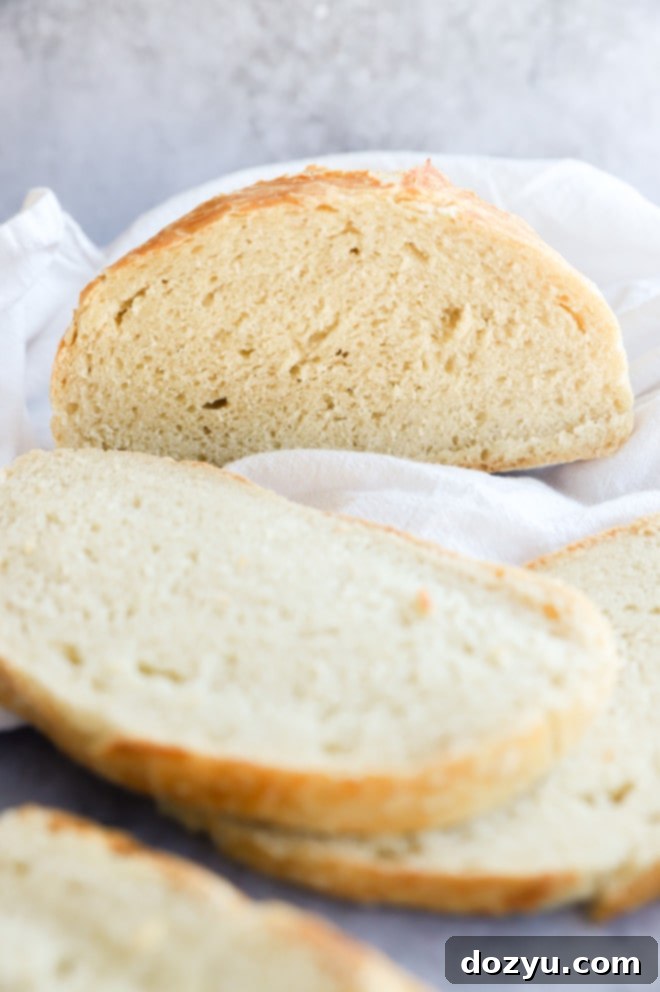
Essential Ingredients for Your No-Knead Bread
This straightforward recipe relies on just four fundamental ingredients, proving that sometimes, less truly is more when it comes to flavor and texture.
Bread Flour: While you can certainly use all-purpose flour for this recipe, I highly recommend using bread flour. Bread flour contains a higher protein content, which translates to more gluten development. This extra gluten provides a superior chewy texture and a stronger structure, yielding a loaf with better rise and a more satisfying bite. When measuring your flour, always use the spoon and level method: spoon the flour into your measuring cup and then level it off with a straight edge. This prevents compaction and ensures an accurate measurement, which is crucial for the dough’s consistency.
Yeast: Instant yeast is the preferred choice for this recipe due to its convenience. It doesn’t require activation in warm water beforehand and can be mixed directly with the dry ingredients. If you only have active dry yeast on hand, don’t worry! You can absolutely use it, but you’ll need to proof it first. Please refer to the FAQ section below for detailed instructions on how to properly activate active dry yeast to ensure your bread rises beautifully.
Salt: Salt is more than just a seasoning; it plays a vital role in bread making. It enhances flavor, regulates yeast activity, and strengthens the gluten structure. For baking, I always reach for fine salt, as it dissolves easily and distributes evenly throughout the dough. Both kosher salt or sea salt will work wonderfully in this recipe, just ensure they are fine-grained for best results.
Water: The temperature of your water is critical for activating the yeast. It needs to be warm, ideally around 110˚F (43˚C). You can achieve this by heating water gently on the stovetop or using warm water straight from your tap. However, to avoid killing the yeast with water that’s too hot or hindering its activity with water that’s too cold, I strongly recommend using a cooking thermometer to verify the temperature before adding it to your other ingredients. This small step ensures optimal yeast performance and a successful rise.
Essential Tools for No-Knead Bread Success
Crafting this no-knead bread requires just a few key pieces of equipment, most of which you likely already have in your kitchen. To accommodate the significant overnight rise of the dough, you will need a generously sized mixing bowl – grab the largest one from your set. A sturdy wooden spoon is perfect for combining the ingredients, ensuring everything is well incorporated without overworking the dough. Once mixed, plastic wrap will be essential for covering the bowl, creating a sealed environment that encourages proper fermentation and rise.
The baking process itself relies on a large Dutch oven with a lid. This crucial piece of equipment traps steam around the dough during the initial baking phase, creating that signature crispy, golden crust and a soft, airy interior, mimicking the conditions of a professional baker’s oven. Finally, once your magnificent loaf emerges from the oven, a cooling wire rack is indispensable. Allowing the bread to cool completely on a rack prevents the bottom from becoming soggy and helps maintain its desired texture before you slice into it with a sharp bread knife.
My Favorite Baking Tools
Dutch oven
Buy Now →
Mixing bowls
Buy Now →
Measuring cups
Buy Now →

Here’s How to Make Overnight Artisan Bread
Making this incredible artisan-style bread is surprisingly simple, requiring minimal hands-on time thanks to its clever overnight proofing method. Follow these easy steps to bake a perfectly crusty, flavorful loaf.
Step 1: Make the Dough
In your largest mixing bowl, combine the bread flour (or all-purpose flour if using), instant yeast, and salt. Whisk these dry ingredients together thoroughly to ensure even distribution of the yeast and salt. Next, pour in the warm water, ensuring it’s at the ideal temperature of 110˚F (43˚C) to activate the yeast properly. Using a sturdy wooden spoon, stir the mixture until all ingredients are just combined. At this stage, the dough will appear shaggy, sticky, and quite wet—this is exactly the consistency you want for a no-knead dough. Avoid overmixing; just ensure no dry pockets of flour remain.
Step 2: The Overnight Rest
Once your dough is mixed, cover the bowl tightly with plastic wrap. This tight seal is crucial to prevent the dough from drying out and to create a humid environment for optimal fermentation. Let the dough rest undisturbed at room temperature for a minimum of 12 hours, and up to 18 hours. This long, slow fermentation is the secret to developing the rich, complex flavors and characteristic airy texture of artisan bread without any kneading. You’ll know the dough is ready for the next step when its surface is visibly dotted with numerous bubbles, indicating that the yeast has been active and has produced sufficient gas.
Step 3: Form and Preheat
After its long rest, gently remove the dough from the bowl onto a lightly floured work surface. Sprinkle a little more flour over the dough and carefully fold it over itself a couple of times. This helps to build a bit more structure and create tension without traditional kneading. Cover the dough loosely with plastic wrap once more and let it rest for another 15 minutes. This short rest allows the gluten to relax, making the dough easier to handle.
Next, turn the dough over onto a large piece of parchment paper, ensuring the smoother side is facing up. Gently form the dough into a round ball. Lightly flour the top of this dough ball, cover it loosely with plastic wrap again, and let it rest while your oven preheats. During this time, preheat your oven to a blazing 450˚F (232˚C). Crucially, place your empty Dutch oven (uncovered) into the oven as it preheats. Allow the Dutch oven to preheat for a full 20 to 30 minutes. This step is vital for achieving that perfectly crisp crust, as the intensely hot Dutch oven will provide an immediate burst of heat to the dough.
Step 4: Bake to Perfection
With great care and using thick oven mitts, remove the screaming hot Dutch oven from the preheated oven. Using the edges of the parchment paper as handles, carefully lift and transfer the dough ball into the hot pan. Cover the Dutch oven with its lid and place it back into the oven. Bake for an initial 30 minutes. This covered baking period traps steam, creating a moist environment that allows the crust to expand without hardening too quickly, resulting in a beautiful oven spring.
After 30 minutes, carefully remove the lid from the Dutch oven. This will allow the steam to escape and the crust to brown and crisp up. Continue baking for an additional 10 to 20 minutes, or until the crust reaches your desired level of golden doneness. You can go for a lighter golden hue or a deeper, more robust golden-brown, depending on your preference. Once baked, carefully remove the bread from the Dutch oven (still using the parchment paper if it’s still intact) and transfer it to a wire rack to cool. It’s essential to let the loaf cool for at least 30 minutes before slicing and serving. This cooling time allows the internal structure to set and prevents a gummy texture, ensuring a perfect slice every time.
Everyday Seasonal Cookbook
With seasonal produce guides, recipes, and more, this cookbook is filled with seasonal food for every occasion.
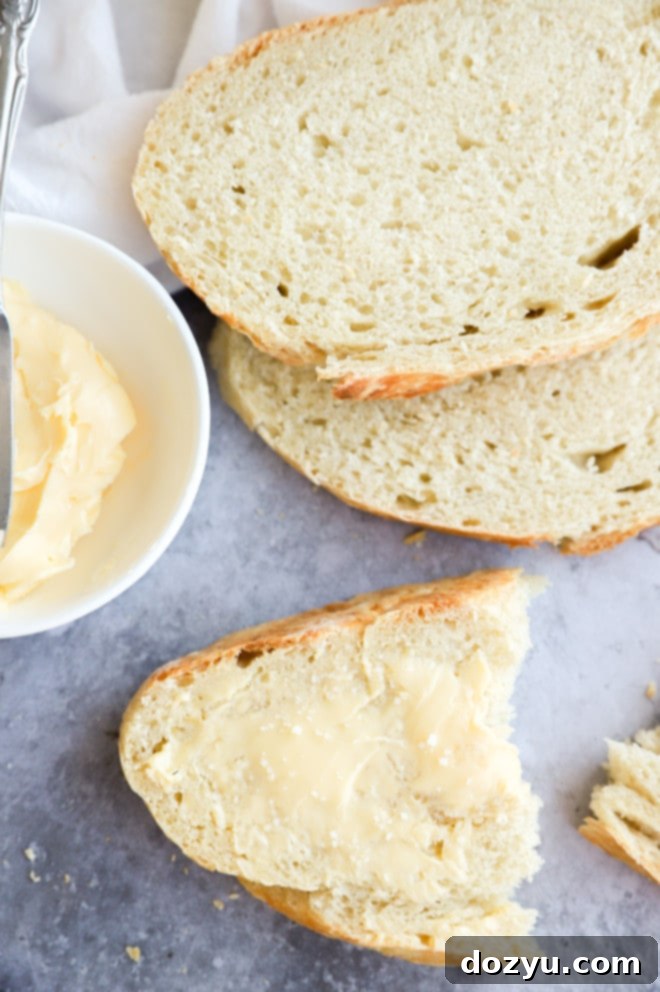
Delicious Variations for Your Homemade Bread
One of the best things about this easy no-knead bread recipe is how incredibly versatile it is! You can customize it with a wide array of additions to suit your taste. Here are some of our favorite ways to infuse extra flavor into your loaf, simply by mixing them into the dry ingredients during Step 1 of the recipe:
- Fresh Herbs: Elevate your bread with aromatic fresh herbs such as finely chopped rosemary, thyme, oregano, or sage. These herbs impart a wonderful fragrance and savory depth. If fresh herbs aren’t available, dried herbs or popular herb mixes like Herbes de Provence or Italian seasoning work just as well, adding a delightful herbal essence to every slice.
- A Kick of Pepper: For those who appreciate a subtle spicy bite, freshly cracked black pepper is a fantastic addition. About 1 to 2 teaspoons, depending on your preferred intensity, can be stirred in during the initial mixing phase (Step 1). It provides a pleasant contrast and a gourmet finish to your bread.
- Garlic Infusion: Transform your no-knead bread into a savory garlic masterpiece by incorporating a couple of cloves of minced garlic. For an even richer, sweeter garlic flavor, consider using minced roasted garlic. This addition creates a fragrant loaf that’s perfect for garlic bread lovers or for pairing with Italian dishes.
- Cheesy Goodness: Stir in a half cup of your favorite shredded cheese, such as cheddar, Gruyère, or Parmesan, to the dry ingredients for a rich, savory loaf.
- Nutty & Seeded: For added texture and nutrients, mix in a quarter cup of sunflower seeds, pumpkin seeds, flax seeds, or chopped walnuts. These additions create a hearty, wholesome loaf perfect for breakfast or with soups.
- Sweet & Spiced: For a delightful treat, add a quarter cup of dried cranberries or raisins along with a teaspoon of cinnamon and a pinch of nutmeg. This transforms the bread into a warm, spiced loaf, perfect for a cozy morning.
Craving more delicious baked goods? Explore these tasty bread recipes: Harvest Pumpkin Seed Bread | Jalapeño Cheddar Biscuits | No Yeast Bread (Soda Bread) | Garlic Bread Bites
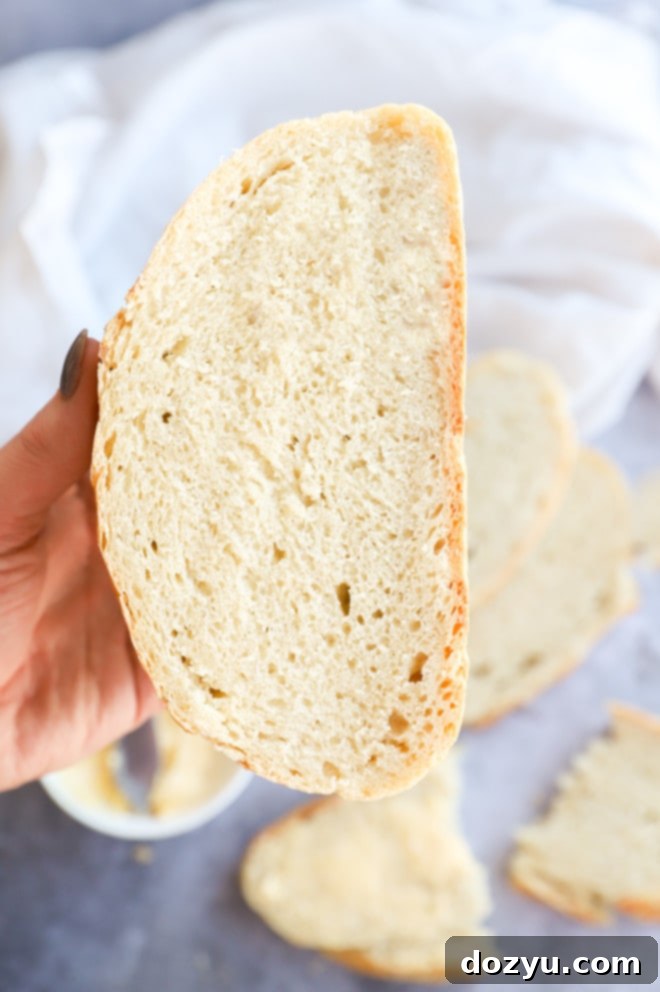
Will the Parchment Paper Burn at High Temperatures?
This is a common and valid concern when baking at high temperatures! Rest assured, high-quality parchment paper is designed to withstand significant heat. Most brands of parchment paper have a temperature limit of 425˚F to 450˚F (218˚C to 232˚C), which falls within the range required for this recipe. It’s always a good practice to check the specific temperature rating on the box of your chosen brand for confirmation. Personally, I have been using parchment paper for baking at these temperatures for many years and have never encountered an issue with it burning or catching fire. The key is to ensure you are using genuine parchment paper, not wax paper, which has a much lower heat tolerance.
Can I Use an Enameled Dutch Oven?
Absolutely! An enameled Dutch oven is an excellent choice for baking this no-knead bread. Many bakers prefer them for their aesthetic appeal and ease of cleaning. Before using it for bread, I highly recommend giving it a very thorough cleaning to ensure there’s no residual grease or food particles, especially if you’ve used it for cooking savory dishes. This precaution helps to prevent any potential staining of the enamel and ensures a clean, pure bake. While enameled Dutch ovens work perfectly, I personally have a great fondness for my classic cast iron Dutch oven from Lodge; both options will yield fantastic results.
Can I Use Active Dry Yeast Instead of Instant Yeast?
Yes, you can certainly use active dry yeast if that’s what you have on hand. The key difference is that active dry yeast needs to be “proofed” or activated before being mixed with the dry ingredients. To do this, simply add the active dry yeast along with a small pinch of granulated sugar (this acts as food for the yeast) to your warm water (around 110˚F). Stir gently and let it sit for about 5 to 10 minutes. You’ll know it’s ready when the mixture becomes foamy and bubbly on the surface, indicating the yeast is active and alive. Once proofed, proceed to add this yeast-water mixture to your flour and salt, then continue with Step 2 as directed. Remember to use granulated sugar for proofing, as honey can sometimes inhibit yeast activity.
Can I Use Whole Wheat Flour Instead?
This recipe has been primarily tested with all-purpose flour and bread flour, as these flours typically provide the ideal gluten structure and chewiness for this specific no-knead method. Whole wheat flour contains the entire wheat kernel, including the bran and germ, which can interfere with gluten development, resulting in a denser loaf. If you wish to incorporate whole wheat flour, I recommend a blend: start by substituting half of the bread flour with whole wheat flour (e.g., 1 2/3 cups bread flour and 1 2/3 cups whole wheat flour). This ratio often provides a good balance, adding nutty flavor and fiber without overly compromising the texture. Please note that you might need to adjust the water slightly, as whole wheat flour can absorb more liquid. Feel free to experiment, and I’d love to hear your results if you try this or any other flour substitute!
Need more inspiration for bread? Check out my bread recipes page!
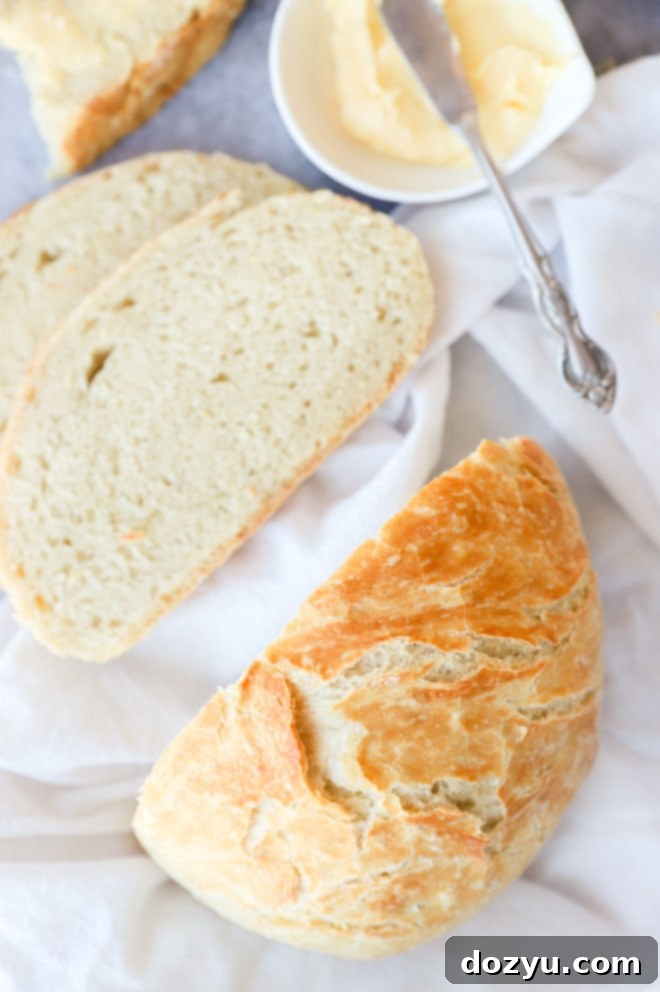
What to Serve with a Fresh Loaf of Bread
A warm, crusty loaf of homemade bread is a versatile culinary canvas, ready to complement a multitude of dishes. My ultimate go-to serving suggestion is simple yet profoundly satisfying: slather a generous amount of rich, creamy Irish butter (Kerrygold is simply divine) onto a slice, and finish it with a delicate sprinkle of flaky sea salt (fleur de sel adds a wonderful crunch). For an extra burst of flavor, a dollop of homemade garlic herb butter is absolutely heavenly! You can even use this to create your own version of sourdough garlic toast, offering all the garlicky goodness without needing a sourdough starter.
Beyond these simple pleasures, the possibilities are endless:
- Sandwich Perfection: Slice it up thick for hearty sandwiches. A classic grilled cheese becomes an elevated experience with this bread! Alternatively, toast a slice and use it as a base for an open-face classic Waldorf salad sandwich.
- Soup’s Best Friend: Tear off generous hunks to pair with your favorite comforting soups. Its robust texture holds up beautifully to dunking in rich bowls of Instant Pot Tomato Soup, creamy Pumpkin and Sweet Potato Soup, savory Tuscan White Bean Soup, hearty Instant Pot Chicken Stew, or luscious Roasted Butternut Squash Soup.
- Morning Indulgence: Enjoy a slice slathered with your favorite jam or marmalade alongside your morning coffee for a simple, delightful breakfast.
- Dipping Delight: Dip it generously into a fragrant basil oil for an appetizer that tastes like a Mediterranean escape.
- Homemade Croutons: Don’t let any leftovers go to waste! Chop up older slices into cubes, toss with olive oil and seasonings, and toast them to create delicious homemade croutons for salads or soups.
- Pasta Pairing: Toast slices with garlic butter to serve alongside an easy 20-minute pasta Napolitana, soaking up all that delicious sauce.
- Dip Companion: Serve toasted bread points for dipping into creamy concoctions like this cold spinach dip, ethereal whipped ricotta, or a warm, bubbly Maryland crab dip!
Let your imagination be your guide – this homemade bread is ready for anything you can dream up!
How to Store and Reheat Your Loaf
Proper storage is essential to keep your homemade no-knead bread fresh and delicious for as long as possible. Here’s how to best preserve your efforts:
Storing at Room Temperature: For immediate enjoyment, store the cooled loaf wrapped tightly in aluminum foil or plastic wrap. This method helps to retain moisture and prevents the bread from going stale too quickly. It will stay wonderfully fresh at room temperature for 2 to 4 days, depending on your environment. For a softer crust, plastic wrap is ideal. If you prefer a slightly crisper crust, aluminum foil allows for a bit more air circulation.
Refrigeration: While not always recommended for whole loaves as it can dry out bread more quickly, if you need to extend its shelf life, you can store slices or a wrapped loaf in the refrigerator for up to 7 to 10 days. Just be aware that the texture might become a little firmer, but a quick toast will usually revive it beautifully.
Freezing for Longer Storage: To truly save your bread for future enjoyment, freezing is an excellent option. This bread can be frozen for up to 3 months without significant loss of quality. To prepare it for freezing, ensure the loaf is completely cooled. Then, wrap it first in a tight layer of plastic wrap, followed by a second protective layer of aluminum foil. This double-wrapping prevents freezer burn and maintains its fresh flavor and texture. When you’re ready to enjoy it, simply thaw the bread at room temperature, then refresh it in a preheated oven (around 350˚F for 10-15 minutes, or until warmed through and crusty again).
Reheating Slices: For individual slices, a toaster or toaster oven works perfectly to bring back that satisfying crispness and warmth. You can also briefly warm slices in a pan on the stovetop for a few minutes per side.
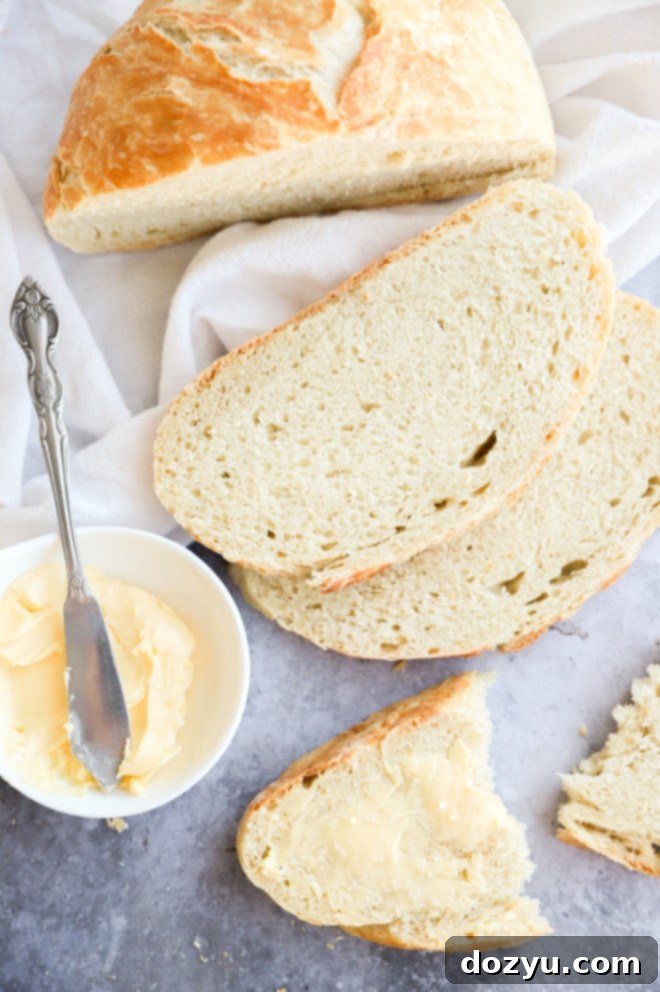
Finally, if you make this incredible no-knead overnight bread recipe, please be sure to give this recipe a rating or leave a comment! I absolutely love hearing about your baking successes and genuinely take the time to respond to every single comment. Feel free to drop any questions you might have below as well!
Oh, and be sure to tag me on Instagram if you share your creations! Seeing these delicious recipes come to life in your homes is truly my favorite thing, and I adore looking through those photos. It really means the world to me!
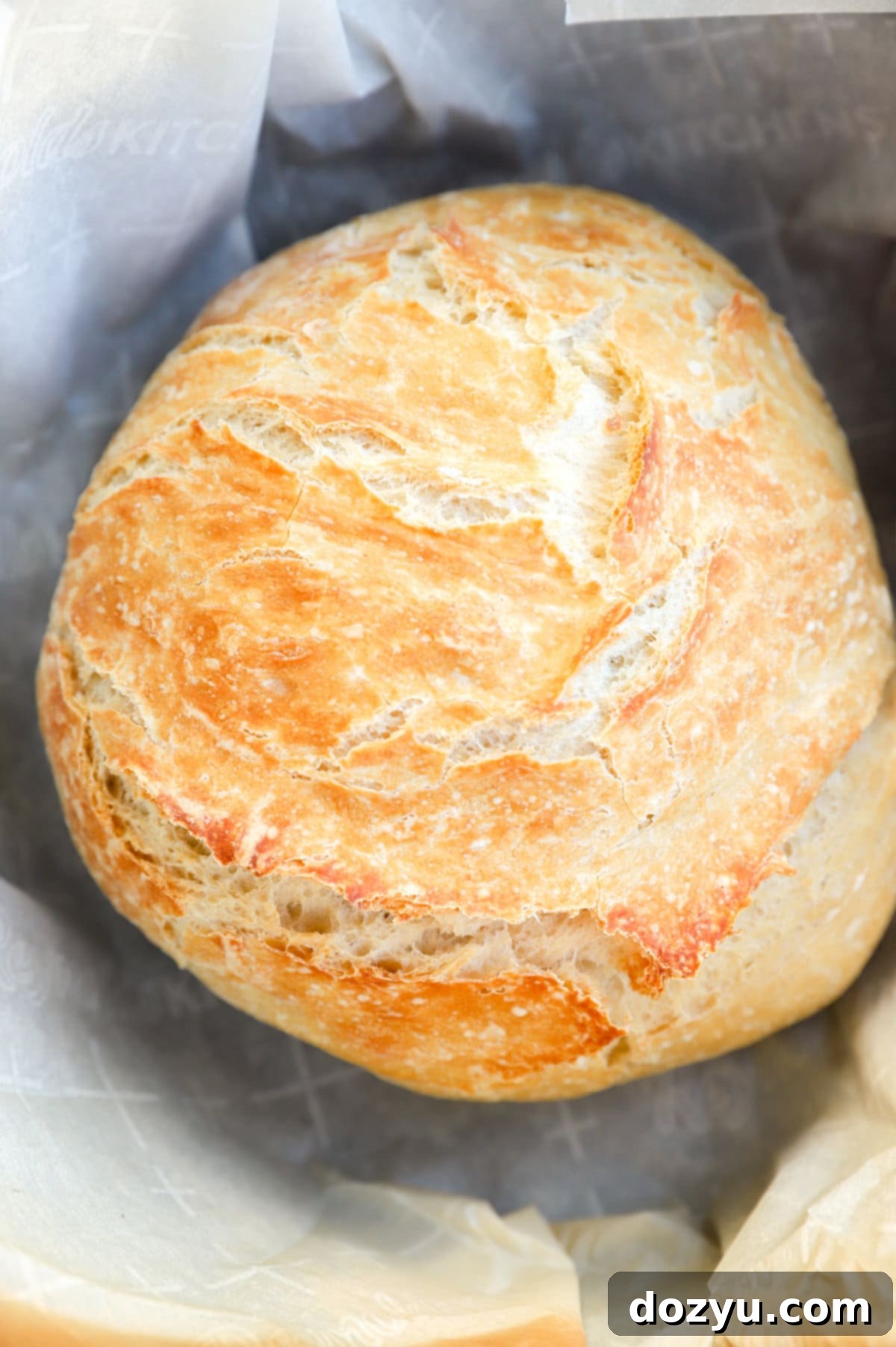
Overnight No-Knead Bread
Equipment
-
Measuring Spoons
-
Measuring Cups
-
Long Wooden Spoon
-
Mixing Bowls
-
Dutch Oven
Ingredients
- 3 1/3 cups all-purpose or bread flour plus more for dusting
- 1/2 tsp instant yeast
- 2 tsp kosher salt
- 1 1/2 cups warm water about 110˚F
Instructions
-
In a large bowl, stir together flour, yeast, and salt until combined.
-
Add warm water and stir until evenly mixed. The dough will be sticky and shaggy. Cover tightly with plastic wrap and let sit overnight at room temperature (at least 12 hours, up to 18 hours).
-
When the dough’s surface is dotted with bubbles, it’s ready! Place dough on a lightly floured surface and fold it over on itself a couple of times. Cover loosely with plastic wrap and let rest for 15 minutes.
-
Turn dough onto a large piece of parchment paper, smooth side up. Use your hands to form the dough into a circle. Sprinkle the top lightly with flour and loosely cover again with plastic wrap to rest while oven preheats.
-
Place Dutch oven in the oven and preheat to 450˚F. Let the oven preheat for at least 20 to 30 minutes.
-
Carefully remove the Dutch oven from the oven using oven mitts. Lift the edges of parchment and place the dough into the preheated pan. Cover and bake for 30 minutes.
-
Remove lid carefully and bake for an additional 10 to 20 minutes until the crust is as golden and crisp as you like it.
-
Cool for at least 30 minutes on a wire rack before serving.
